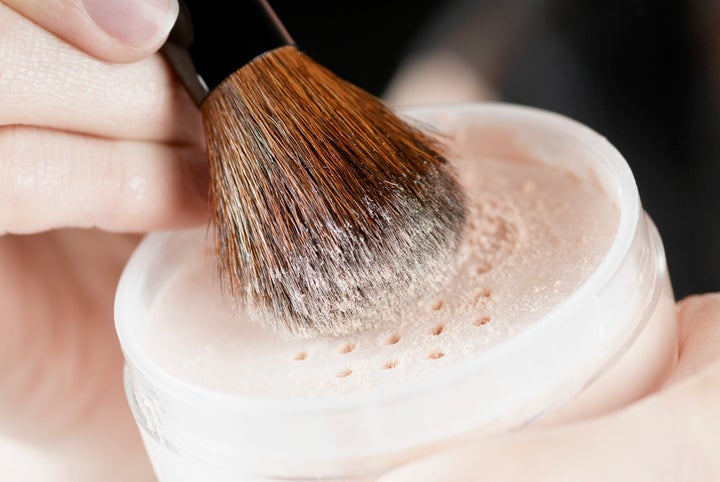Beauty products are often filled with ingredients that most of us probably don’t recognize ― and can’t even pronounce. While that’s not inherently a bad thing, there is a rising emphasis on clean beauty and keeping an eye out for potentially dangerous chemicals like parabens and phthalates. And another ingredient in many makeup products that’s been called into question is talc.
Last year, the HBO Max docuseries “Not So Pretty” explored the use of talc in cosmetics in its debut episode, “Makeup,” which looked at the compound’s potential connection to cancer-causing asbestos, as well as other health concerns. The show prompted many TikTok users to post videos of themselves throwing out their talc-containing products.
If you’re wondering whether you should be doing the same, the answer is: It’s a little complicated.
“It is a personal decision whether to use makeup products with talc or not, and consumers should weigh the potential risks and benefits based on their circumstances and preferences,” Dr. Aanand Geria, a board-certified dermatologist based in New Jersey, told HuffPost.
But what exactly are those risks and benefits? Below, Geria and other experts break down the role of talc in makeup and the controversy about its safety.
First, what is talc?
“Talc is a powdered substance made from naturally occurring minerals, including hydrous magnesium silicate, oxygen and hydrogen,” said Dr. Melanie Palm, a board-certified dermatologist at Art of Skin MD in the San Diego area. “It’s often used in a range of personal care and makeup products, like dry shampoo, face powder, blush, eyeshadow and baby powder to absorb moisture or achieve a matte or opaque texture.”
The word “talc” can refer to both the clay mineral talc and the soft white talcum powder made from that mineral. As noted, this powder is found in a variety of cosmetic products.
“Talc is a naturally occurring mineral that is mined from the earth, specifically rock deposits,” said Ron Robinson, a cosmetic chemist and founder of the skin care brand BeautyStat. “It is known as one of the softest minerals and has been used for centuries as a lubricant.”
What does talc do in makeup?
“One of the reasons talc is such a common ingredient in cosmetics is that it is affordable and widely available,” Geria said. “It is added to these products because it helps absorb moisture and oil, giving them a smooth and silky texture.”
He noted that talc is chemically inert, meaning it doesn’t react with other ingredients in cosmetics, so it’s a stable and safe option in that regard. It’s also odorless.
“Talc helps add texture to certain products,” said Dr. Karan Lal of Affiliated Dermatology in Scottsdale, Arizona. “It also dilutes pigments when formulations are created for different skin shades. It helps absorb moisture and allows formulations to stay on the skin. It makes makeup products more spreadable. And lastly, it’s an affordable way of thickening certain products.”
Talc offers a nice, soft feel and matte look, though not all makeup users are fans.
“In creams and lotions, chemists use water as a filler,” noted cosmetic chemist Ginger King. “But when the product form cannot take water but powder, talc is often the choice. Still, some people find that it has a chalky finish and they may prefer other options that are less chalky.”

What are the concerns with talc?
“There is a concern about the safety of talc in makeup due to its potential to be contaminated with asbestos, a carcinogenic mineral,” Geria said. “Asbestos is commonly found close to talc deposits, which has resulted in some talc products being contaminated with asbestos. When inhaled or applied to the skin, talc containing asbestos can lead to serious health problems, including lung cancer and mesothelioma.”
He noted that the International Agency for Research on Cancer has classified talc as “possibly carcinogenic to humans.” Studies have suggested that people who are regularly exposed to talc particles, especially talc miners, may be at increased risk of developing lung disease or cancer.
“There is an ongoing question of a possible link between ovarian cancer and the use of talc-containing powders in the genital area,” said New York-based board-certified dermatologist Dr. Hadley King (no relation to Ginger). “This became publicized when Johnson & Johnson was ordered to pay millions to the family of a woman who died from ovarian cancer after using a talc-containing powder in the genital area for many years.”
Studies aimed at elucidating this risk are still in progress, as previous research has not been satisfactorily conclusive to many in the scientific community. Unfortunately, there are design and execution challenges for these types of studies.
“Because there is the potential risk for talc to be contaminated with asbestos, the FDA tests some talc-containing cosmetics for asbestos,” Hadley King explained. “But some argue that these tests can be flawed and inaccurate. And some studies have supported the idea that even asbestos-free talc may be carcinogenic.”
Parents of infants have been particularly concerned about talc in baby powder.
“In the 1980s, the American Academy of Pediatrics issued a warning to parents to avoid using talc on babies and children, claiming it increases the likelihood of exposure to carcinogens, respiratory illness, and possible lung damage,” Palm said.
Facing thousands of consumer safety lawsuits, Johnson & Johnson announced in 2022 that it would stop selling talc-based baby powder worldwide ― just two years after the company decided to discontinue these products in the U.S. and Canada. The plan is to focus on its cornstarch-based baby powder, which has no known links to cancer.
“The Johnson & Johnson litigation has spurred a shift away from talc-based powders that were commonly used on babies’ bottoms and in other feminine hygiene products, as well as talc-free condoms,” said Dr. Rhonda Klein, co-founder of Modern Dermatology of Connecticut.
Long-term illness isn’t the only potential issue with products containing talc.
“It can also cause skin irritation, particularly in delicate areas that may rub together ― e.g. under the breasts or in the groin or abdominal folds,” Hadley King said.
Is it safe in makeup?
Although pure talc by itself is not generally considered a dangerous mineral, its proximity to asbestos in the earth and potential for contamination gives many medical experts pause.
“Several organizations, including the American Cancer Society, have stated that more research is needed to fully understand the potential risks of talc,” said Dr. Divya Shokeen, a board-certified cosmetic dermatologist and founder of the Ocean Skin & Vein Institute in California. “Ultimately, though talc is widely used in makeup and is considered safe by regulatory agencies, the potential risks associated with talc cannot be completely ruled out.”
There are also questions about the role and authority of said regulatory agencies. The U.S. Food and Drug Administration “considers it unacceptable for cosmetic talc to be contaminated with asbestos,” but the agency does not actually regulate cosmetics beyond the approval of color additives. Thus, asbestos detection is the responsibility of the manufacturer.
“While the makeup industry is encouraged to follow voluntary toxicology standards set by the Personal Care Products Council, there is no way to enforce this standard industry-wide,” Palm explained.

How do I know if my makeup is OK?
If you’re still hoping to use talc-containing products or want to know more about the ingredients, try to find companies that prioritize transparency and safety. Look for certifications from trusted third parties like the Leaping Bunny Program and the Environmental Working Group.
“Most of [the] time if a product is from quality ingredient suppliers, then yes, it is safe,” said Ginger King. “They have quality control standards which can detect [the] asbestos level.”
And while the FDA does not regulate cosmetics, the agency does routinely test certain products (albeit in limited numbers) when safety concerns arise.
“The FDA released the results of its 2022 sampling assignment, testing talc-containing cosmetic products for the presence of asbestos, and asbestos was not detected in any of the 50 samples tested,” Lal said. “This means companies are getting better and smarter about trying to procure asbestos-free talc.”
Testing and regulation aside, the experts who spoke to HuffPost said it’s generally best to use caution when applying talc-based products, and to take special care to avoid inhaling anything containing this ingredient or getting it near the genitals.
“While not obvious, some products like loose powders and blushes are unintentionally inhaled,” Lal said. “I would find talc-free powders or blushes to avoid unintended inhalation. It’s hard to say talc from one type of makeup causes mesothelioma, because it takes 20-plus years to develop that type of cancer. If you have lung issues, it is best to avoid loose talc-based products.”
Some experts noted that pressed cosmetic powders are a safer bet than loose powders or aerosolized varieties of talc. But most recommended turning to the many talc-free alternatives if you’re concerned about potential carcinogen exposure. You may also prefer other options if talc simply irritates your skin.
“Many makeup brands now use silica, zinc oxide, cornstarch or boron nitride as safer alternatives for absorbing excess oil or providing a mattifying texture,” Palm said.
Other popular substitutes include rice starch, tapioca starch, kaolin, oat flour and mica. That last one is a favorite of Deanne Mraz Robinson, the other co-founder of Modern Dermatology of Connecticut.
“If you’re looking to avoid talc overall, mica is an excellent replacement mineral. Mica is ground into a powder that gives off a pearly sheen and is commonly found in highlighting products, bronzers and eyeshadows,” said Mraz Robinson, who recommended the ISDIN Mineral Brush for its ability to absorb shine and brighten the complexion, and for its SPF 50 protection.
“Personally, I do avoid products containing talc,” said Dr. Blair Murphy-Rose, a board-certified dermatologist based in New York. “I generally err on the side of caution with ingredients that may be harmful, particularly when there are effective alternatives that are known to be safe. We do not have clear enough data to fully [understand] or quantify the harm, but in my opinion there is enough question raised to warrant avoidance.”
When seeking talc-free cosmetic alternatives, just make sure the products you purchase fit that description.
“Talc is a naturally derived mineral, so just because a product is labeled ‘natural’ does not mean it is talc-free,” Mraz Robinson explained. “If you are looking to avoid talc, read your labels carefully.”
